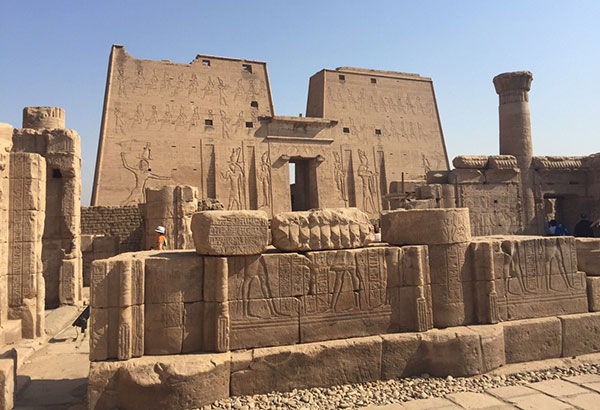Edfu, Abu Simbel & Philae: Egypt’s ancient treasures


The Temple of Horus in Edfu, Egypt Photos by Bum Tenorio Jr.
The 6 a.m. sun was a bit friendlier at 39 degrees when the Nile Goddess docked in the old Egyptian town of Edfu. The night before, we had been lulled by the Nile River from the city of Luxor, about 115 kilometers away from Edfu.
From our cabin, the clip-clopping of horses’ hooves could be heard. Dust spiraled in midair, making the horses sneeze or neigh. There was revelry in the road as horse carriages (locally called caleche) ruled the early morning scene.
A toothy, burly man driving a caleche pulled by and an energetic horse stopped before our group. First to take the ride were my BFF Bum Tenorio, Anna Ayo and me. The caleche pulled away and off we went to the Temple of Horus (also known as the Temple of Edfu), considered as the best-preserved cult temple in Egypt because it was built in the Ptolemaic era from 237 BC to 57 BC. It is the second largest temple in Egypt after the Karnak Temple (which I discussed in my last column).
The Temple of Edfu is dedicated to Horus, considered as the national deity of Egypt, according to our tour guide Shereen Touson. Horus takes the form of a man with a head of a falcon. Above its head is a pschent (a red and white crown) to symbolize his being king of the entire Egypt.
Shereen explained that Horus, son of goddess Isis, was conceived after his mother found all the dismembered body parts of her murdered husband Osiris. (Egyptian mythology tells us that Osiris was murdered by Set out of jealousy.) But Isis was not successful in locating one body part of Osiris — his penis, which was thrown into the Nile and eaten by a catfish. Shereen said, “With her magical powers, and the dismembered body parts before her, Isis resurrected Osiris and created a golden phallus so the couple could conceive Horus.”
The people of Edfu are friendly but can also be very pushy when they sell their wares. You give in because the highly knowledgeable vendors add to your understanding of Edfu.
The caleche brought us back to the cruise ship. Bum, still holding on to Doraemon, the cute Japanese toy entrusted to him by his dear friend Rodge Valientes, kept repeating the story of how Horus was conceived.
The Nile Goddess continued to sail the Nile River. To Abu Simbel we disembarked the following day and were mesmerized by the treasures of the city.
Abu Simbel is a quaint village in the town of Nubia in southern Egypt. The village is located between the high dam and the Egyptian-Sudanese borders. When the whole of Nubia was submerged under the water of the lake, the Nubians fled to the New Nubia, 30 km north of Aswan.
During the reign of the pharaohs, many temples were elevated by different kings but the most spectacular are the two temples of Ramses II and Nefertari in Abu Simbel. These two temples carved out from solid, massive rock were built by King Ramses II, arguably the greatest ruler of the kingdom of Egypt, during his 67-year of kingship from 1290-1224 BC. Ramses built the temples for himself and dedicated them to goddess Hathor. The smaller temple is called Nefertari Temple because it is dedicated to the wife of Ramses, Queen Nefertari.
Shereen mentioned that Hathor is an ancient Egyptian goddess who represented the concept of happiness and joy, feminine love and motherhood. She is also the goddess of music, dance and foreign lands. In the tomb paintings inside the Abu Simbel temples, Hathor is often depicted welcoming the dead into the afterlife.
Very interesting to note are the four gigantic seated figures of Ramses that welcome guests to the rock-cut façade of the temple. The façade is 119 feet wide and 100 feet high. The four statues are uniform in height at 67 feet. Above the colossal figures is a row of baboons, regarded as the “Watchers of Dawn.” The Egyptians respect the baboons because they believe the baboons played a pivotal role in helping the sun god Ra in defeating the enemies who represented the darkness of night. Therefore, the baboons are believed to be sacred to the worship of the rising sun.
Very close to the Ramses Temple is the Nefertari Temple, which also has interesting and mind-blowing chambers depicting the ancient Egypt. Nefertari was a highly educated Egyptian queen and the first of the so-called “Great Royal Wives.” Her name means “beautiful companion” and she is one of the best known Egyptian queens next to Cleopatra VII, Nefertiti and Hatsepsut.
Going to the Abu Simbel temples from the parking lot is quite a walk so it’s best to wear very comfortable shoes. As I said in my previous articles on Egypt, the best time to visit Egypt is between November and February, when the temperature is cooler. We were in Egypt in September when it was broiling — between 38 degrees and 52 degrees Celsius.
The hottest we had been in Egypt was in Aswan. Bum sprinkled himself with cold water before getting off the air-con bus. It helped that we took a small boat to navigate the lake surrounding another ancient temple called Philae.
Philae is an island in the city of Aswan. Philae is a Greek word that means “the end,” and indeed, the place defines the southernmost limit of Egypt.
The oldest part of Philae is a temple in honor of Isis — yes, the goddess who gave birth to Horus by finding the dismembered parts of her husband Osiris and fashioning a golden phallus. The Philae temple was built by Nectanebo I, Shereen said, during 380 to 362 BC. For the most part of the temple, the other ruins date back from the Ptolemaic Kingdom (282 to 145 BC), as evidenced by Roman works.
The Temple of Philae is now in its new location and how it was transferred is an engineering feat even in modern times. The temple was almost lost when the high Aswan dam was built in the 1960s. However, the Egyptian government and UNESCO were quick to respond to save the ancient temple. Modern technology allowed the temple to be rescued when its every stone block was labeled and removed piece by piece and, like a jigsaw puzzle, reassembled on the higher ground of Agilka island. It took 10 years to complete the relocation project that saved one of Egypt’s most beautiful ancient temples.
To visit the temples of Edfu, Abu Simbel and Philae is to be in close proximity with the ancient world. Egypt is more than fascinating. Its every town or village or city is built upon a solid-as-an-Egyptian-rock culture and heritage as old as time.
The temples are waiting. And in them you discover Egypt’s ancient treasures.
* * *
For inquiries about tours to Egypt, call the Manila office of Royal Way Tours at 0919-4306630, 0915-8686895, 02-2634829. Email the author at miladay.star@gmail.com.


















